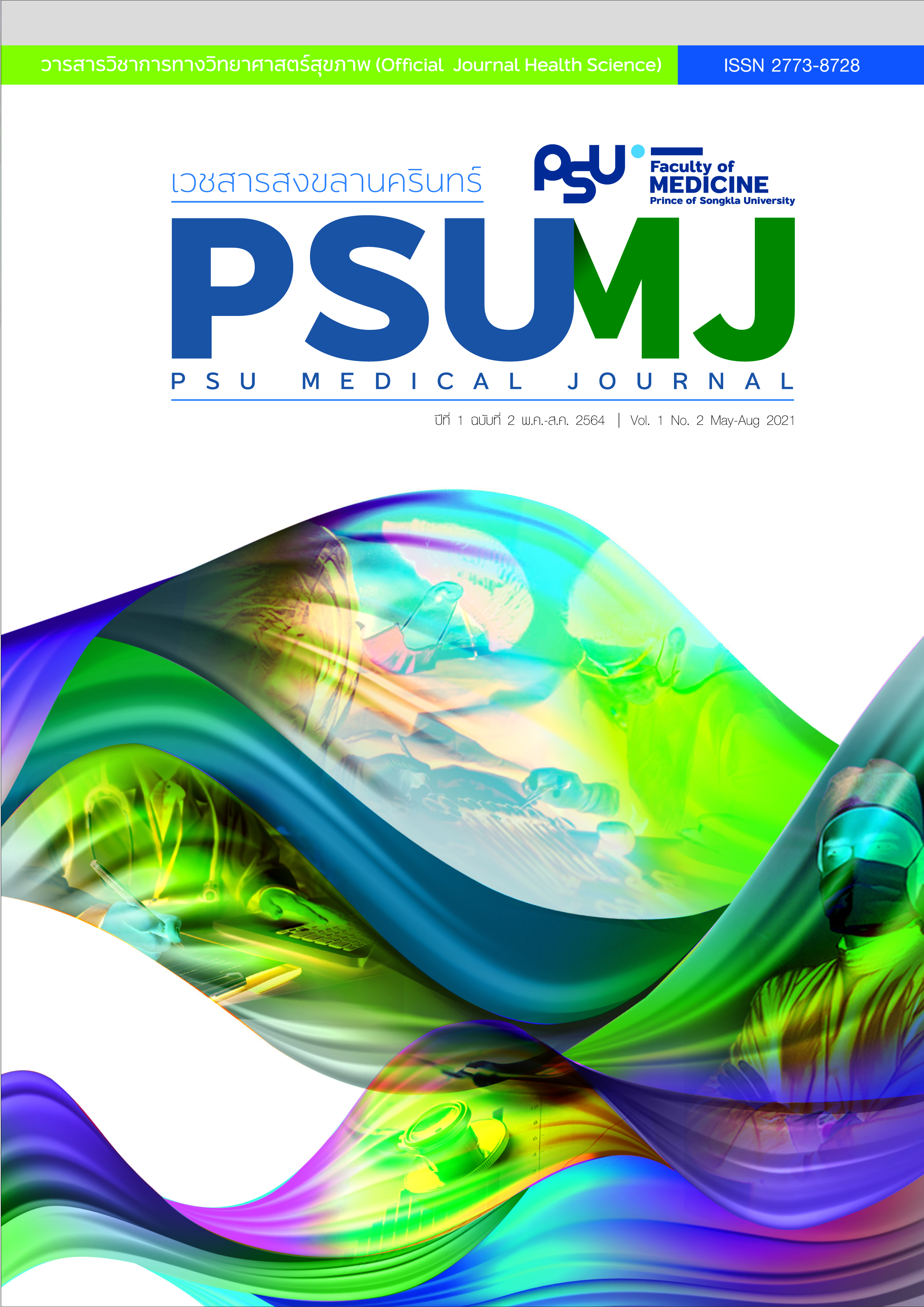Central Precocious Puberty in Girls: Diagnosis, Management and Outcome
Central Precocious Puberty in Girls
DOI:
https://doi.org/10.31584/psumj.2021246082Keywords:
gonadotropin, gonadotropin-releasing hormone, precocious puberty, pubertyAbstract
Puberty is a normal physiological process of during which children develop secondary sex characteristics, experience growth acceleration, and achieve bone maturation and reproductive competence. The onset of puberty is initiated by the activation of the hypothalamic-pituitary-gonadal (HPG) axis. Precocious puberty is defined as the appearance of secondary sex characteristic at an age younger than 8 years in girls and 9 years in boys, or the beginning of menstruation before 9 years in girls. The most common etiology of central precocious puberty (CPP) is idiopathic (>90.0% in girls and 25.0-60.0% in boys), in which at present the etiologies of idiopathic CPP in some patients can be identified to be from a mutation of KISS1 or MKRN3 genes. The standard treatment for CPP is a gonadotropin-releasing hormone analog (GnRHa). The aims of treatment are to halt and regress the pubertal status of the patient to the prepubertal state that is appropriate for their age, prevent early onset of menses and attenuate the loss of height potential consequence upon advanced skeletal maturation. A study of long-term follow-ups of former CPP women at the age of mid-20s to 50 years found that most of the participants had regular menstrual cycles. The marital status and the pregnancy rate were the same as in controlled group and were not different between the GnRHa-treated and untreated CPP women.
References
Barroso A, Roa J, Tena-Sempere M. Neuropeptide control of puberty: beyond kisspeptins. Semin Reprod Med 2019;37:155-65.
Livadas S, Chrousos GP. Control of the onset of puberty. Curr Opin Pediatr 2016;28:551-8.
Abreu AP, Kaiser UB. Pubertal development and regulation. Lancet Diabetes Endocrinol 2016;4:254-64.
Eugster EA. Update on precocious puberty in girls. J Pediatr Adolesc Gynecol 2019;32:455-9.
Brito VN, Spinola-Castro AM, Kochi C, Kopacek C, Silva PC, Guerra-Júnior G. Central precocious puberty: revisiting the diagnosis and therapeutic management. Arch Endocrinol Metab 2016;60:163-72.
Latronico AC, Brito VN, Carel JC. Causes, diagnosis, and treatment of central precocious puberty. Lancet Diabetes Endocrinol 2016;4:265-74.
Silveira LG, Noel SD, Silveira-Neto AP, Abreu AP, Brito VN, Santos MG, et al. Mutations of the KISS1 gene in disorders of puberty. J Clin Endocrinol Metab 2010;95:2276–80.
Pita J, Barrios V, Gavela-Pe´rez T, Martos-Moreno GÁ, Muñoz-Calvo MT, Pozo J, et al. Circulating kisspeptin levels exhibit sexual dimorphism in adults, are increased in obese prepubertal girls and do not suffer modifications in girls with idiopathic central precocious puberty. Peptides 2011;32:1781–86.
Skrapits K, Borsay BA, Herczeg L, Ciofi P, Liposits Z, Hrabovszky E. Neuropeptide co-expression in hypothalamic kisspeptin neurons of laboratory animals and the human. Front Neurosci 2015;9:29.
Hagen CP, Sørensen K, Mieritz MG, Johannsen TH, Almstrup K, Juul A. Circulating MKRN3 levels decline prior to pubertal onset and through puberty: a longitudinal study of healthy girls. J Clin Endocrinol Metab 2015;100:1920–26.
Roberts SA, Kaiser UB. Genetic etiologies of central precocious puberty and the role of imprinted genes. Eur J Endocrinol. 2020;183:R107-17.
Li W, Liu Q, Deng X, Chen Y, Liu S, Story M. Association between obesity and puberty timing: a systematic review and meta-analysis. Int J Environ Res Public Health 2017;14:1266.
Reinehr T, Roth CL. Is there a causal relationship between obesity and puberty? Lancet Child Adolesc Health 2019;3:44-54.
Vazquez MJ, Velasco I, Tena-Sempere M. Novel mechanisms for the metabolic control of puberty: implications for pubertal alterations in early-onset obesity and malnutrition. J Endocrinol 2019;242:R51-65.
Jaruratanasirikul S, Mo-suwan L, Lebel L. Growth pattern and age at menarche of obese girls in a transitional society. J Pediatr Endocrinol Metab 1997;10:487-90.
Vazquez MJ, Velasco I, Tena-Sempere M. Novel mechanisms for the metabolic control of puberty: implications for pubertal alterations in early-onset obesity and malnutrition. J Endocrinol 2019;242:R51-65.
Aguirre RS, Eugster EA. Central precocious puberty: From genetics to treatment. Best Pract Res Clin Endocrinol Metab 2018;32:343-54.
Jaruratanasirikul S, Thaiwong M. Etiologies of precocious puberty: 15-year experience in a tertiary hospital in southern Thailand. J Pediatr Endocrinol Metab 2010;23:1263-71.
Carel JC, Roger M, Ispas S, Tondu F, Lahlou N, Blumberg J, Chaussain JL. Final height after long-term treatment with triptorelin slow release for central precocious puberty: importance of statural growth after interruption of treatment. J Clin Endocrinol Metab 1999;84:1973-8.
Cassio A, Cacciari E, Balsamo A, Bal M, Tassarini D. Randomised trial of LHRH analogue treatment on final height in girls with onset of puberty aged 7.5-8.5 years. Arch Dis Child 1999;81:329-32.
Klein KO, Barnes KM, Jones JV, Feuillan PP, Cutler GB Jr. Increased final height in precocious puberty after long-term treatment with LHRH agonists: the National Institutes of Health experience. J Clin Endocrinol Metab 2001;86:4711-16.
Tanaka T, Niimi H, Matsuo N, Fujieda K, Tachibana K, Ohyama K, et al. Results of long-term follow-up after treatment of central precocious puberty with leuprorelin acetate: evaluation of effectiveness of treatment and recovery of gonadal function. The TAP-144-SR Japanese Study Group on central precocious puberty. J Clin Endocrinol Metab 2005;90:1371-6.
Pasquino AM, Pucarelli I, Accardo F, Demiraj V, Segni M, Di Nardo R. Long-term observation of 87 girls with idiopathic central precocious puberty treated with gonadotropin-releasing analogs: impact on adult height, body mass index, bone mineral density, and reproductive function. J Clin Endocrinol Metab 2008;93:190-5.
Brito VN, Latronico AC, Cukier P, Teles MG, Silviera LF, Arnhold JP, et al. Factors determining normal adult height in girls with gonadotropin-dependent precocious puberty treated with depot gonadotropin-releasing hormone analogs. J Clin Endocrinol Metab 2008;93:2662-9.
Magiakou MA, Manousaki D, Papadaki M, Hadjidakis D, Levidou G, Vakaki M, et al. The efficacy and safety of gonadotropin-releasing hormone analog treatment in childhood and adolescence: a single center, long-term follow-up study. J Clin Endocrinol Metab 2010;95:109-17.
Jaruratanasirikul S, Thaiwong M. Outcome of gonadotropin-releasing analog treatment for children with central precocious puberty: 15-year experience in southern Thailand. J Pediatr Endocrinol Metab 2011;24:519-23.
Poomthavorn P, Suprasit R, Mahachoklertwattana P. Adult height, body mass index and time of menarche of girls with idiopathic central precocious puberty after gonadotropin-releasing hormone analogue treatment. Gynecol Endocrinol 2011;27:524–8.
Lee PA, Neely EK, Fuqua J, Yang D, Larsen LM, Mattia-Goldberg C, Chwalisz K. Efficacy of leuprolide acetate 1-month depot for central precocious puberty (CPP): growth outcomes during a prospective, longitudinal study. Int J Pediatr Endocrinol 2011;2011:7.
Wankanit S, Mahachoklertwattana P, Pattanaprateep O, Poomthavorn P. Basal serum luteinising hormone cut-off, and its utility and cost-effectiveness for aiding the diagnosis of the onset of puberty in girls with early stages of breast development. Clin Endocrinol (Oxf) 2020;92:46-54.
Cantas-Orsdemir S, Garb JL, Allen HF. Prevalence of cranial MRI findings in girls with central precocious puberty: a systematic review and meta-analysis. J Pediatr Endocrinol Metab 2018;31:701-10.
Bangalore Krishna K, Fuqua JS, Rogol AD, Klein KO, Popovic J, Houk CP, et al. Use of Gonadotropin-Releasing Hormone Analogs in Children: Update by an International Consortium. Horm Res Paediatr 2019;91:357–72.
Guaraldi F, Beccuti G, Gori D, Ghizzoni L Long-term outcomes of the treatment of central precocious puberty. Eur J Endocrinol 2016;174:R79-87.
Lazar L, Lebenthal Y, Yackobovitch-Gavan M, Shalitin S, de Vries L, Phillip M, et al. Treated and untreated women with idiopathic precocious puberty: BMI evolution, metabolic outcome, and general health between third and fifth decades. J Clin Endocrinol Metab 2015;100:1445-51.
Colmenares A, Gunczler P, Lanes R. Higher prevalence of obesity and overweight without an adverse metabolic profile in girls with central precocious puberty compared to girls with early puberty, regardless of GnRH analogue treatment. Int J Pediatr Endocrinol 2014;2014:5.
Satitpatanapan, P, Jaruratanasirikul, S, Sriplung, H. Menstrual cycle, reproductive function, body mass index, and metabolic profiles of women with former central precocious puberty: 10-20-year longitudinal cohort study in southern Thailand. J Pediatr Endocrinol Metab 2020;33:933-40.
Azziz R, Carmina E, Dewailly D, Diamanti-Kandarakis E, Escobar-Morreale HF, Futterweit W, et al. Positions statement: Criteria for defining polycystic ovary syndrome as a predominantly hyperandrogenic syndrome: an Androgen Excess Society guideline. J Clin Endocrinol Metab 2006;91:4237-45.
Wolf WM, Wattick RA, Kinkade ON, Olfert MD. Geographical prevalence of polycystic ovary syndrome as determined by region and race/ethnicity. Int J Environ Res Public Health 2018;15:E2589.
Jensen AM1, Brocks V, Holm K, Laursen EM, Müller J. Central precocious puberty in girls: internal genitalia before, during, and after treatment with long-acting gonadotropin-releasing hormone analogues. J Pediatr 1998;132:105-8.








